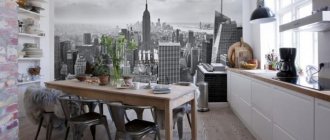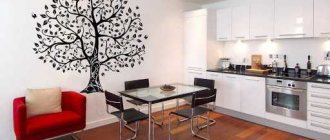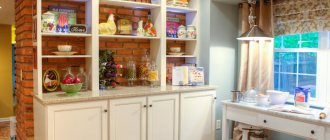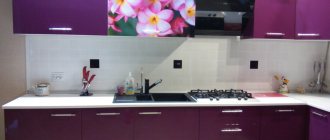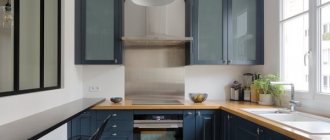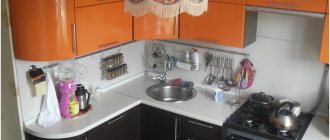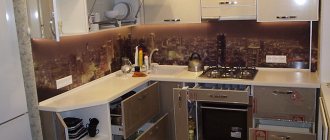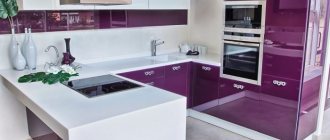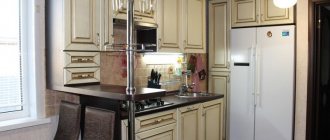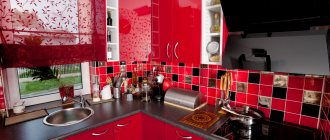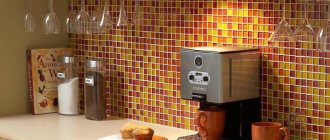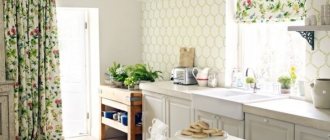Accent wall
It is designed to attract attention, that is, it is better to make it bright and unusual. These can be coatings with large flowers, photo wallpapers, geometric designs, etc. It is important not to overdo it with paints, otherwise the interior will be oversaturated and lose its uniqueness.
For it, choose bright wallpaper or wallpaper with a pattern. The remaining walls serve as a background, so it is better to choose plain wallpaper for them.
Glass wallpaper
Their fiberglass wallpaper is very durable, fire resistant, and can be painted up to 15 times. The coating is environmentally friendly and not harmless to humans.
Microbes and bacteria have nowhere to take nutrients from, so fungus and mold will not grow underneath them.
These properties make them an ideal material for kitchen finishing. According to their texture, they are divided into two types - smooth and textured.
Vertical combination
It is optimal for narrow and long rooms. It also allows you to make ceilings visually higher.
When coming up with a design for combined wallpaper for the kitchen, pay attention to the photos below. On them you will see one of the most common finishing methods - vertical combination.
Vertical stripes. You can create a unique play of light and color by covering the walls alternately with stripes of different wallpaper. You can combine both contrasting colors and shades of the same color, creating a gradation.
You can choose wallpaper of the same shade, but with different textures - for example, alternate matte and glossy.
An interesting option: alternating wallpaper with a pattern and plain ones. The resulting stripes imitate real paintings. This technique is appropriate in a spacious kitchen.
The photo shows a harmonious combination in the English style - at the bottom, vertical stripes create an imitation of wall panels, at the top is a classic floral pattern. The joint between the two types of wallpaper is decorated with a decorative border.
The most commonly used wallpaper is striped. They can be located:
- Symmetrical. In this case, the walls are covered with wide stripes mirrored from the center. Contrasting colors attract the eye, so few people pay attention to the disproportion of the room configuration.
- Asymmetrical. Only one wall is covered with canvases with wide stripes, while canvases with a similar pattern, but of different widths, are applied to other surfaces. This makes the room look wider.
Correctly selected colors will also help to place accents in the room. Too bright shades should be alternated with pastels 1-1 or 1-2. It all depends on the size of the room and the desired effect.
The secret of proper pasting
Wallpaper is glued only to the treated surface. All differences and cracks are covered with putty, and the surface behind the battery is especially carefully prepared. It is important that the first thing to do is treat the areas affected by the fungus, then prepare the glue and wallpaper.
For your information, thick wallpaper can only withstand thick compositions; they are applied especially intensively to the area behind the radiator.
- To ensure that the glue is evenly saturated, the coated coating is left wrapped for 5 minutes.
- Work begins from the window, paying special attention to the area behind the radiator.
- Clear alignment to the mark with a paint cord will help ensure that the wallpaper is perfectly vertical.
- The glued base is carefully smoothed, expelling air bubbles. The area behind the battery is treated especially carefully, because even a slight increase in temperature will lead to peeling of the fabric.
Horizontal companion wallpaper
Used in rooms with high ceilings, it fits perfectly into any interior design. Designers use this move to transform an overly tall room.
The photo shows a combined wallpaper with horizontal stripes and a floral pattern.
You can combine wallpapers of different textures and shades horizontally. Choose options that are in harmony with each other and with the overall design of the kitchen.
To calculate the height of each strip, visually divide the wall into three horizontal parts. The narrowest strip should be located at the bottom.
One of the most popular solutions is to use wooden or cork panels in the lower part. The top can be covered with coverings with geometric patterns, large flowers, or simply bright plain fabrics.
If the lower part stands out with a bright and large ornament, then it is better to choose a plain top.
Striped wallpaper, separated from the top part by a border or molding, can also be used as panels. At the top it is better to use canvases with small patterns or single-color ones.
You can vary either colors or texture. It’s worth choosing an option that will complement the overall design of your room, presenting it in the most favorable light.
Zoning
Combined wallpaper for the kitchen separates the working and dining areas. Recently, it has become very popular to create an accent area. For it, you can choose a bright color or an original pattern, and for the rest of the area choose calm, monochromatic colors.
The materials should be of the same density, this will look more harmonious. Stores offer a large selection of ready-made sets, which include wallpaper for the accent area and for the general background. The colors in the set combine perfectly, and the result is a stylish and modern interior.
Patchwork
Patchwork is an original combination technique that is appropriate in country, Provence or ethno style. Wallpaper with different patterns is cut into equal pieces and pasted over the wall, alternating blocks.
There should be no more than 3-4 designs and number of color solutions. It is also not uncommon to see a ready-made pattern on wallpaper in the patchwork style.
The photo shows bright wallpaper in the patchwork style. They give the interior coziness and a feeling of home warmth.
In the process of choosing source materials, you should be guided by the compatibility of colors, compliance with a given style and common sense. In this way you can decorate a fragment of a surface or one wall from floor to ceiling. It all depends on the courage of your idea.
This option is worth a closer look for those who gravitate towards a variety of textures and color shades, but cannot find a suitable solution for themselves.
The work ahead is quite complex, since initially it is necessary to select the optimal combinations, and only then create an effective picture from disparate pieces.
Patchwork attracts creative individuals who dream of transforming their home and are able to carry out such painstaking work on their own.
Useful tips from the experts
1. The opinion that cheap wallpaper is easier to glue is a misconception. Ease of use directly depends on the quality of the material. If you have little experience, choose textured wallpaper, this will help hide minor flaws.
2. Walls should be thoroughly cleaned of debris. Lumps found on wallpaper that has already been pasted over may turn out to be pebbles or particles of old materials. To correct the situation you will have to tear off the panel.
3. Rusty spots will sooner or later appear on the surface. To avoid this result, glue a small piece of film over the stains. It will create a barrier impenetrable to corrosion.
Photo wallpaper and 3D
Photo wallpapers immediately become bright accents. Therefore, for the remaining walls it is better to choose plain wallpaper in soft colors.
3D images have also become one of the popular varieties of our time, creating the effect of presence and volume.
A beautiful cityscape creates an accent and gives a sense of volume to the room.
The choice of options is incredibly wide, ranging from classic food and drink themes (fruits, coffee and coffee beans, chocolate) to three-dimensional abstraction.
Such a picture should be as open as possible for viewing, so it is best to apply it to the most open surface possible. In most cases, the only one is the wall in the area of the dining table.
They can be created on any basis: non-woven, synthetic fabrics, vinyl. High-quality paints make them bright and resistant to fading even in direct sunlight.
They are also environmentally friendly, fire-resistant, wear-resistant, and easy to maintain. To wash them, you can use any household chemicals. But still, the most significant and impressive advantage is its incredible aesthetics. In addition, absolutely any image can be transferred to the canvas.
In the interior of a small kitchen
A small kitchen is present in many apartments, especially older ones, the layout of which makes it impossible to expand it. Housewives usually get used to cooking in such a limited area, but a large kitchen is still their dream. Designers know how to at least visually enlarge a room, including with the help of photo wallpaper.
You can visually increase the area
They must be light shades. The basic rule: the smaller the kitchen itself, the smaller the print on the photo wallpaper should be. Massive images will look ridiculous: an enlarged large fruit, especially in dark colors. Small flowers would be a good option; if these are products, then they should be small, small in size.
Also, to decorate a small kitchen, it is important to choose suitable wallpaper for the remaining walls. The simplest design solution for enlarging a room is to use stripes, both vertical and horizontal. The former will make the kitchen visually higher, and the latter - wider.
Stripes are a great option for combination
Tip Using stripes for small rooms does not mean that there will be nothing else on the roll except them. Many of the designs contain the same flowers, geometric shapes, and patterns with stripes.
Photo wallpaper covering the entire wall is not suitable for a small kitchen; it is better to limit yourself to small fragments. You can use them for the area between the work surface (table, stove) and hanging kitchen cabinets or the ceiling. If you apply them to the entire wall, it will look ridiculous, and in a small room there is unlikely to be an entire free wall.
It is better to focus on only one wall
Combination with other types of finishes
A combination of wallpaper and other finishing materials looks much more interesting: tiles, bricks, concrete, painting, wood panels, cork, decorative plaster, mosaics.
There are hundreds of options, but there are a few general rules.
- 1 Same thickness. The thickness of the coatings should be approximately the same, which will eliminate problems with joining.
- 2 Do not use expensive and budget analogues at the same time. Give preference to materials from the same price category that differ in texture and color.
- 3 Same shine. For example, matte tiles look bad against the backdrop of shiny, glossy wallpaper. It is desirable that the degree of gloss be as identical as possible.
- 4 In combination with any wallpaper, even the most expensive, another finishing material still becomes accentuated. Therefore, it is better to rely on neutral colors for wallpaper.
- 5 Adhere to zoning principles. Chaotic inserts of other finishing materials around the perimeter of the entire kitchen will bring disharmony. Complement large prints with wallpapers with small patterns or plain colors, and rich colors with pastels.
You will find more original ideas for using combined wallpaper for the kitchen in the interior in the photos provided.
Everyone can find individual solutions for themselves, striking in sophistication and exclusivity.
The right color combination
You need to select colors in accordance with the overall design of the kitchen. The wall covering should become a background that improves the mood and creates comfort. It is not recommended to use many colors on wallpaper at once. A harmonious design is obtained by combining 2-3 colors.
- Cool colors - gray, blue, blue, green - combine well with each other.
- Warm colors are yellow, red, orange, they allow you to make the kitchen lighter.
- Neutral colors are gray, beige, white, black. Combine with any shades, patterns and prints on wallpaper.
Mosaic
This is not just a small tile, it is a whole art. With the help of quickly installed and affordable mosaic panels, they decorate kitchen splashbacks, highlight niches and shelves, highlight the shower counter, decorate the bathtub or sink, frame mirrors and cabinets. Against the background of larger segments of tiles or porcelain stoneware, such accents work in full force, especially if they shine or have an unusual texture.
An artistic panel carefully laid out from a mosaic always looks more expensive than it costs, and does an excellent job as the “heart” of the interior.
Ceiling
Finishing the ceiling in the kitchen can be done in many ways: plasterboard and suspended ceilings, foam boards, plastic panels, painting. Wallpapering the kitchen is the easiest, low-budget and fastest option. Even if for some reason the appearance of the wallpaper deteriorates, gluing new ones will not be difficult, unlike dismantling the same drywall. It is better to choose smooth wallpaper that will not accumulate dust and grease, and a coating of light shades will help to visually “raise” the ceiling. This finishing is simple and can be done independently.
Stone
By successfully combining ceramic tiles with artificial stone or natural rock, you will get a respectable interior with a strong personality, because the design will always be unique. This solution is definitely suitable for those who need to beautifully decorate a small studio apartment and softly play up the transition from the kitchen to the dining room or living room.
It’s easy to emphasize the richness and naturalness of the matte, rough structure of the stone using glossy tiles - add them to adjacent walls or lay them on the floor.
Additional recommendations
When decorating the kitchen interior, you need to calculate the consumption of finishing materials. To do this, measure the perimeter of the room. If you bought wide rolls, for every meter of wall you need one strip, the length of which is equal to the height of the room. To glue products 53 cm wide, two sheets are required. Standard roll is 10 or 15 m.
Knowing these values, you can calculate how much it costs to wallpaper a kitchen with an area of 10, 20 square meters or more. For example:
- The dimensions of the room are 3x4x2.5 m, perimeter 14.
- Wide stripes need 14 pieces, narrow stripes - 28.
- A roll is 10 m, per strip you need 2.5 + 0.10 = 2.6.
- The number of canvases will be 10/2.6=3.8 - 3 stripes.
- Consumption – 14/3=4.67 – 5 meter rolls or 28/3=9.3 – 10 rolls 53 cm wide.
Similarly, calculate the amount of material to glue the walls on the kitchen partition or create an artistic composition. The remains of wallpaper can be used to decorate the space above the window or door.
Many people are interested in what is better: painting the walls or gluing them in the kitchen. The answer depends on many nuances: financial capabilities, desire to frequently change the interior, and the presence of children at home. As an option, you can choose a material for further painting if you want to update the interior.
Sources
- https://LeroyMerlin.ru/offer/oboi-kompanony/
- https://kitchenizer.ru/kombinirovannie-oboi-na-kuhne/
- https://kitchendecorium.ru/remont/steni/sozdaem-na-kuxne-unikalnyj-dizajn-pravilno-kombiniruem-oboi.html
- https://proffstroygroup.ru/remont/oboi-dlya-kuhni-dizajn.html
- https://dizainifoto.com/kuhnya/kak-pravilno-kombinirovat-oboi-kompanony-mezhdu-soboj-na-kuhne/
- https://lafoy.ru/kombinirovanie-oboev-na-kuhne-100-foto-idey-422
- https://design-homes.ru/idei-dlya-doma/oboi-kompanony
- https://dizainkyhni.com/remont-kuhni/oboi-dlya-malenkoj-kuxni.html
- https://kleyguru.ru/materialy/oboi/kakie-pokleit-na-kuhne.html
[collapse]
Dye
Waterproof paints are more affordable than good wallpaper, and they open up even more space for creativity. Owners who love variety and frequent changes usually take up a brush or roller, because if the interior is based on discreet tiles, it will be easy to transform it in a matter of minutes by repainting the walls and ceiling. Everything goes well with white, gray and black tiles, as we said at the very beginning, so you can choose a pleasant combination of 2-3 shades.
In addition to paint, decorative plaster, such as Venetian plaster, which can also have moisture-proof properties, looks advantageous in tandem with tiles.
What to look for when purchasing
Whatever wallpaper you choose, you should pay close attention to the purchasing process itself.
Follow our recommendations if you do not want to purchase low-quality wallpaper:
- First of all, remember that good building materials are rarely cheap. Explore the range of online stores and read our article where good brands are listed. Are they offering you something much cheaper? Most likely, the wallpaper will fall off in the first month or the colors will lose saturation.
- Do not purchase wallpaper in markets or dubious stores. Storage conditions are not always observed there, which means you risk purchasing damp goods.
- Take careful measurements before purchasing and be sure to take a roll in reserve. No matter how carefully you glue the wallpaper, there is always a risk of ruining something in the process.
- Have you decided to buy embossed wallpaper? Carefully inspect each roll: scuffs and scratches may appear not only during operation, but also due to manufacturing defects. It will be difficult to exchange such a roll.
- Study the specifications carefully. Not every coating is suitable for use in kitchen conditions.
As you can see, there is nothing difficult in choosing wallpaper for a small kitchen. And in order to better decide on the choice of wallpaper for a small kitchen, we suggest you look at real photo examples.
